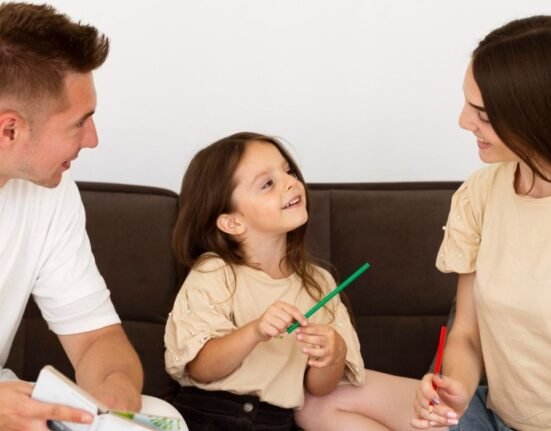Parenting is an intensely individual endeavor, informed by a caregiver’s beliefs and background and influenced by a child’s particular temperament. One of the most consequential factors is where a child lands on the introversion-extroversion spectrum — a personality trait that governs how people recharge, engage with the world and manage stimuli. Introverted kids perform better in a calmer, reflective atmosphere, while extroverted kids excel in active, interactive spaces. A psychological perspective helps to appreciate these differences, empowering parents to nurture their child’s strengths, limit challenges, and foster a healthy sense of self.
Read More: Everything You Need To Know About the 4 types of Introverts
Understanding Introversion and Extroversion
Introversion and extroversion as concepts were first popularized by Carl Jung in the early 20th century and later refined by psychologists such as Hans Eysenck and, more recently, researchers of the Big Five personality traits. In contrast, introversion is all about the internal dimension, less-stimulated environments, and restrained interaction. Extroversion, on the other hand, is a preference for more external stimulation, social interaction, and higher-energy environments. These characteristics all exist on a continuum — most children display a combination of the two — but many lean very much to one side or the other, which in turn affects how they respond to parenting strategies.
Studies indicate these proclivities may be partially innate. A landmark study of infant temperament by the psychologist Jerome Kagan found that roughly 20 percent of babies showed “high-reactive” traits, or hypersensitivity to noise, light and change, often correlating with introversion, while “low-reactive” infants, more easygoing and daring, tended toward extroversion. Neuroscience backs this up further, demonstrating how introverts possess a higher degree of baseline activity in the prefrontal cortex (which processes internally) while extroverts experience greater dopamine sensitivity, pushing them toward reward-seeking behaviors like socializing.
For parents, knowing these traits early on will colour their meaning of their child’s behaviour. An introverted child’s silence is not always shyness or stand-offishness; an extroverted child’s loudness is not automatically stubbornness or hyperactivity. The trick is finding equitable ways to raise them.
Parenting the Introverted Child
Introverts can behave differently and require time to take in their thoughts and emotions. They might withdraw to their room after a busy day, choose one-on-one playdates instead of group activities or be tentative about speaking in class. Psychologically, this comes from heightened receptivity to external stimuli — too much noise, chatter or novelty overpowers their nervous system, and they retreat.
The research on over-stimulation explains why this matters. One 2012 study in the Journal of Personality and Social Psychology found that introverts have higher cortisol spikes (a stress hormone) than extroverts do in high-stimulation environments. For parents, the takeaway is that pushing an introverted child into continual socialization – through a busy birthday party or a frenetic extended family visit – is often counterproductive, leading to anxiety or melt downs. Instead, effective parenting requires maintaining balance.
Consider a hypothetical, introverted 7-year-old person who does not look forward to school recess. Her mother may think she’s antisocial and encourage her to go with the group. A psychologically informed method, though, would acknowledge her distress — “I know large groups can feel loud and tiring” — and establish her confidence step by step, inviting a calm playdate with a trusted friend, for example. Susan Cain, author of the book Quiet, is one such person who focuses on introversion in her work: parents must fight against their frustration and society’s insistence that quiet children be “fixed,” and instead recognize silence as a gift, as introverts shine in things like creativity, empathy, and deep focus.
Another important aspect is emotional regulation. Introverted children are more likely to keep feelings inside, processing moments before verbalizing them.
Parenting the Extroverted Child
Extroverted children, by comparison, thrive on interaction and activity. They might chatter nonstop, look for new friends on the playground, or object when playtime ends. Psychologically, this is a manifestation of their lower threshold for boredom and higher need for external rewards. Meanwhile, research on dopamine pathways hints that extroverts feed off novelty and social validation — and when they don’t get these, they can act out or succumb to restlessness.
A 2015 study published in Child Development, for example, found that extroverted children display more behavioral problems (such as impulsiveness or aggression) in less structured or stimulating environments. For example, a 9-year-old extrovert stuck in a quiet house all day could annoy his or her brothers and sisters or break rules simply out of boredom. Parents can avoid this by giving the outlets: team sports, group projects, or just a raucous family game night.
These children might also find it difficult to be alone or reflect, which are prerequisites for self-knowledge. A classic study by Eysenck found that extroverts are worse than introverts at tasks that require long tasking as a standalone activity, such as reading or doing homework. Parents can assist too, introducing quiet time gradually — framing it positively (“This is your special thinking time”) — and modeling patience. Over-scheduling may be tempting, but it’s risky; extroverted kids need breaks, too, or they burn out pursuing unending thrills.
Socially, they might monopolize conversations or ignore others’ boundaries. The parenting, here, is about nurturing empathy and restraint.” Role-playing scenarios — “What if your friend wants to play something else?” —can help build perspective-taking, which isn’t always a natural skill for extroverts. Even positive reinforcement works wonders; rewarding them for listening or sharing keeps their reward-driven side involved.
Bridging the Gap: Parental Influence and Adaptation
While introversion and extroversion inform a child’s needs, parenting style plays an intermediating role in how those traits can show up. Decades of research, including work by Diana Baumrind on authoritative, authoritarian and permissive styles, suggest that flexibility is paramount. Authoritarian parenting — warm but with rules — tends to work for both types, but it will look a little different. A child who thrives on alone time may need added leeway to retreat and recharge, while a child brimming with vitality and exuberance will flourish when given steady parameters.
Parental personality also plays a role. An extroverted parent might take an introverted child’s silence personally, mistaking it for rejection, while the introverted parent might become overwhelmed by an extroverted child’s needs. A 2018 study published by Family Psychology found that “personality mismatch” between caregiver and child can take a toll on relationships unless caregivers are purposeful about adapting. That means having some self-awareness: an extroverted mother might make a point to schedule solo time to avoid projecting her social needs onto her introverted son; an introverted father might make the effort to engage in his extroverted daughter’s games.
Cultural context is also a factor. Western societies often celebrate extroversion – think class participation or team sports – which can make introverted kids feel marginalized. Some East Asian cultures, by comparison, emphasize restraint and contemplation – traits that might conflict with an extroverted child’s disposition. Parents have to negotiate these norms, advocating for their child’s temperament rather than coercing them into compliance.
Long-Term Implications
How parents react to introversion or extroversion can shape a child’s sense of self-esteem and resilience. Introverted kids who are urged to “be more outgoing” may internalize shame, and extroverted kids who are admonished for “being too much” may stifle their exuberance. Research from the Journal of Child Psychology and Psychiatry emphasizes that acceptance of a child’s inherent disposition correlates with better mental health outcomes — less anxiety for introverts, fewer conduct problems for extroverts.
In practice, this means celebrating strengths. Introverted children can shine in observation and problem-solving; extroverted children excel in leadership and collaboration. Encouragement tailored to fit —an entry in a science fair for one, a debate club for the other — has fostered confidence without remaking their essence.
Conclusion
It is a matter of understanding rather than changing your child to cultivate their natural tendencies. Introverts require sanctuary and patience; extroverts require stimulation and direction. Psychological research sheds light on these needs, helping us understand that temperament is not an obstacle to be overcome but a platform on which to build. By listening to their child’s inner environment — whether it’s a silent sanctuary or a frenetic stage — parents can help develop not just a personality but a person. Ultimately, you’re not trying to raise an introvert or an extrovert; you’re trying to raise a child who feels seen and supported and free to be who they are.
FAQs
1. Can someone be both an introvert and an extrovert?
A: Yes. These people are known as ambiverts who like to socialize but also need their alone time to recharge.
2. Are introverts shy?
A: Not necessarily. Introversion is about social preferences rather than fear of social situations.
3. Can an introvert become an extrovert
A: Personality traits are relatively stable, but people can change their energy levels or develop skills depending on the situation.
4. What if an extroverted child is too talkative or interrupts often?
A: Teach them active listening, turn-taking and model patience in conversations.
5. How can an introverted child express their thoughts and feelings?
A: Don’t force them to speak; give them time to process their feelings and situations.
References +
- Baumrind, D. (1967). Child care practices anteceding three patterns of preschool behavior. Genetic Psychology Monographs, 75(1), 43–88.
- Cain, S. (2012). Quiet: The power of introverts in a world that can’t stop talking. Crown Publishers/Random House.
- Lansford, J. E., Godwin, J., Al-Hassan, S. M., Bacchini, D., Bornstein, M. H., Chang, L., Chen, B.-B., Deater-Deckard, K., Di Giunta, L., Dodge, K. A., Malone, P. S., Oburu, P., Pastorelli, C., Skinner, A. T., Sorbring, E., Steinberg, L., Tapanya, S., Alampay, L. P., Uribe Tirado, L. M., & Zelli, A. (2018). Longitudinal associations between parenting and youth adjustment in twelve cultural groups: Cultural normativeness of parenting as a moderator. Developmental Psychology, 54(2), 362–377 https://doi.org/10.1037/dev0000416
- Lucas, R. E., & Diener, E. (2001). Understanding extraverts’ enjoyment of social situations: The importance of pleasantness. Journal of Personality and Social Psychology, 81(2), 343–356. https://doi.org/10.1037/0022-3514.81.2.343
- Pinquart, M. (2017). Associations of parenting dimensions and styles with externalizing problems of children and adolescents: An updated meta-analysis. Developmental Psychology, 53(5), 873–932. https://doi.org/10.1037/dev0000295
- Sulik, M.J., Blair, C., Mills-Koonce, R., Berry, D., Greenberg, M. and (2015), Early Parenting and the Development of Externalizing Behavior Problems: Longitudinal Mediation Through Children’s Executive Function. Child Dev, 86: 1588-932. https://doi.org/10.1111/cdev.12386
- Zelazo, P. D. (2015). Executive function: Reflection, iterative reprocessing, complexity, and the developing brain. Developmental Review, 38, 55–68. https://doi.org/10.1016/j.dr.2015.07.001













Leave feedback about this